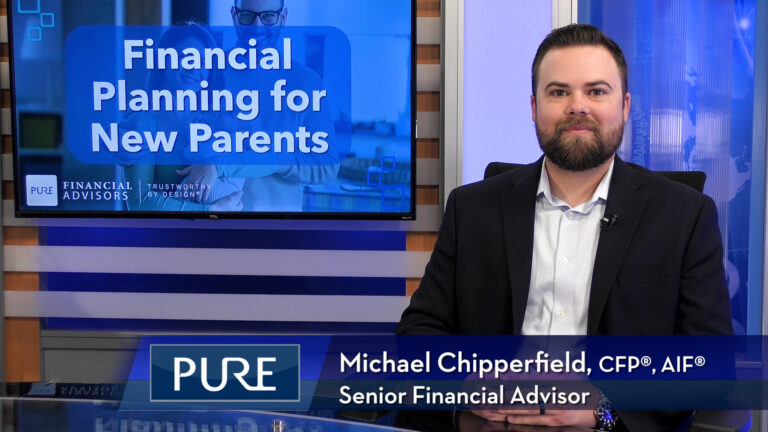When in retirement, your priority will likely shift from earning on investments to safeguarding and preserving your savings. Pure’s Financial Planner, Annie Chen, CFP®, AIF®, points out potential withdrawal trapdoors you may stumble into during retirement.
FREE GUIDE | Withdrawal Strategy Guide
Transcript
Once you’ve transitioned into retirement, it’s less about what you can earn on your investments and more about how much of it you can keep. And what most people don’t realize is that taxes could potentially be one of your largest expenses in your retirement years.
Trapdoor: Tax-Deferred Accounts
When most people start taking withdrawals from their investments, they typically avoid taking funds from their tax-deferred accounts because they want to keep their taxes as low as possible. So they might first draw down their cash or Roth accounts, then their taxable accounts, and wait until everything else has been exhausted before they start taking money from their IRAs and 401Ks. The problem with this strategy is that your future tax bill grows higher and higher, the longer you are in retirement. Since most people have majority of their savings in their IRAs and 401(k)s, eventually they will need to take distributions from these accounts to help cover their expenses. And when they do, every dollar that’s taken out of a tax-deferred account is taxed at ordinary incomes rates. Ordinary income rates are the same tax rate as your wages, so if you take a $100,000 out of your IRA, it’s taxed just like you earned a salary of $100,000. But by then, tax rates might be higher that what they are today. We already know tax rates are scheduled to go up 2026, and it’s unlikely this is the last time you’ll see a tax rate increase throughout your retirement.
Trapdoor: Required Minimum Distributions
But let’s say you’re in a position of not needing to take withdrawals from your tax deferred accounts. Like maybe you have Social Security income, rental income or a pension that covers majority or all of your living expenses. Or maybe you have a significant amount of cash saved up and could live off just that for the rest of your retirement. Well, even if you don’t need to take withdrawals from your IRAs or 401(k)s, the IRS will force you to take withdrawals once you reach your Required Minimum Distribution age. The required minimum distribution age used to be age 70.5, and when they passed the Secure Act of 2019, it was changed to age 72. Now, because of the Secure Act of 2022, the required minimum distribution age is now age 73 for individuals born between 1951 and 1959 and age 75 if you were born in 1960 or later. Once you’ve reached your required minimum distribution age, you are forced to distribute a percentage of all your tax deferred accounts, regardless if you need the money or not. That percentage starts at around 4% and increases each year, so if you avoid taking anything out of your tax-deferred accounts and continue to let it grow until you’re forced to take it out as an required minimum distribution that distribution amount could potentially push you into a much higher tax bracket. And once required minimum distributions begin, they don’t stop, so that higher tax bracket could be the bracket that you stay in for the rest of your lifetime.
Trapdoor: Tax Time Bomb
To avoid this tax time bomb, one strategy is to take distributions more proportionally from each type of account. So each year, consider taking some of your withdrawals from cash, some from your taxable accounts and some from your IRAs and 401(k)s. Taking distributions from your tax-deferred accounts early on prevents your requirement minimum distributions from being too large in the future. This proportional distribution approach generally results in paying less taxes overall.
This is just one withdrawal strategy to consider. There are many more strategies that you could potentially use to not only minimize your taxes, but also the taxes that get passed on to your heirs. If you would like to learn about all the tax savings strategies available to you, reach out to a Pure Financial Advisor today for a free tax analysis.
Subscribe to our YouTube channel.
IMPORTANT DISCLOSURES:
• Investment Advisory and Financial Planning Services are offered through Pure Financial Advisors, LLC, a Registered Investment Advisor.
• Pure Financial Advisors LLC does not offer tax or legal advice. Consult with your tax advisor or attorney regarding specific situations.
• Opinions expressed are subject to change without notice and are not intended as investment advice or to predict future performance.
• Investing involves risk including the potential loss of principal. No investment strategy can guarantee a profit or protect against loss in periods of declining values.
• All information is believed to be from reliable sources; however, we make no representation as to its completeness or accuracy.
• Intended for educational purposes only and are not intended as individualized advice or a guarantee that you will achieve a desired result. Before implementing any strategies discussed you should consult your tax and financial advisors.
CFP® – The CERTIFIED FINANCIAL PLANNER™ certification is by the Certified Financial Planner Board of Standards, Inc. To attain the right to use the CFP® designation, an individual must satisfactorily fulfill education, experience and ethics requirements as well as pass a comprehensive exam. Thirty hours of continuing education is required every two years to maintain the designation.
AIF® – Accredited Investment Fiduciary designation is administered by the Center for Fiduciary Studies fi360. To receive the AIF Designation, an individual must meet prerequisite criteria, complete a training program, and pass a comprehensive examination. Six hours of continuing education is required annually to maintain the designation.












